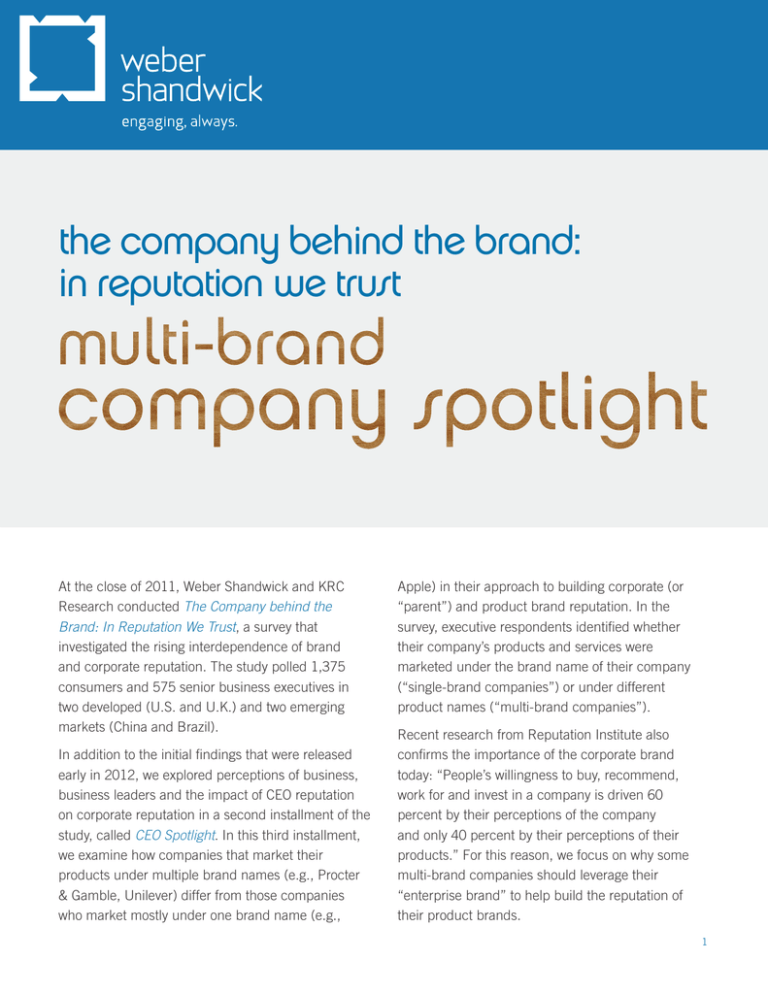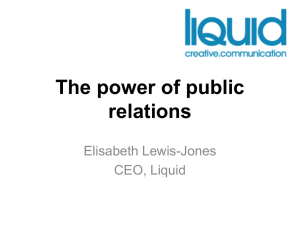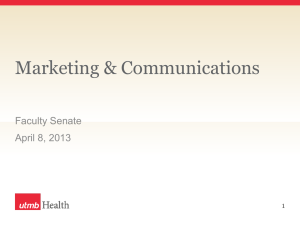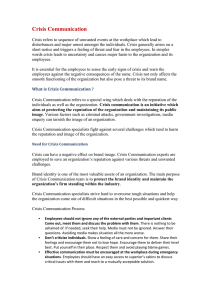the company behind the brand: in reputation we
advertisement

the company behind the brand: in reputation we trust At the close of 2011, Weber Shandwick and KRC Research conducted The Company behind the Brand: In Reputation We Trust, a survey that investigated the rising interdependence of brand and corporate reputation. The study polled 1,375 consumers and 575 senior business executives in two developed (U.S. and U.K.) and two emerging markets (China and Brazil). In addition to the initial findings that were released early in 2012, we explored perceptions of business, business leaders and the impact of CEO reputation on corporate reputation in a second installment of the study, called CEO Spotlight. In this third installment, we examine how companies that market their products under multiple brand names (e.g., Procter & Gamble, Unilever) differ from those companies who market mostly under one brand name (e.g., Apple) in their approach to building corporate (or “parent”) and product brand reputation. In the survey, executive respondents identified whether their company’s products and services were marketed under the brand name of their company (“single-brand companies”) or under different product names (“multi-brand companies”). Recent research from Reputation Institute also confirms the importance of the corporate brand today: “People’s willingness to buy, recommend, work for and invest in a company is driven 60 percent by their perceptions of the company and only 40 percent by their perceptions of their products.” For this reason, we focus on why some multi-brand companies should leverage their “enterprise brand” to help build the reputation of their product brands. 1 Company Reputation is Highly Prized The research revealed that both multi- and single-brand executives strongly believe in the value of company reputation. The majority of both report that… • Reputation matters. At both multi- and single-brand companies, executives estimate that corporate reputation accounts for approximately 60% of a company’s market value and the CEO’s reputation accounts for approximately 50% of the company’s overall reputation. • Reputation-building is underway. A large number of multi- and singlebrand executives report that their companies have been increasing efforts to build reputation during the past few years (80% and 89%, respectively). • Reputation is a communications priority. Multi- and single-brand companies both heavily communicate or promote the overall reputation of their companies (80% and 87%), again by a sizeable majority. Even companies facing the complexities of managing several individual brands find the resources to focus on the parent brand as well. At these multi-brand companies, a large share of reputation-building goes toward company reputation. In fact, the work is almost evenly divided between emphasis on the company’s reputation and the reputation of the individual products (45% vs. 55%, respectively). While we don’t have historical data to gauge the change of these proportions over time, we believe an evolution has taken place in recent years that has transformed the way multi-brand companies market their goods and communicate their reputations. 2 The Parent Brand Evolution At Multi-Brand Companies The majority of multi-brand executives (75%) recognize the importance of the parent brand reputation relative to the product brand. It is not surprising that they lag single-brand company executives on this measure (92%) since the single-brand’s company name is its product brand name. However, such a high rate of conviction among multi-brand executives for the parent brand is striking given the conventional practice to more extensively market their product brands over their corporate brand. This model has worked well for many companies over the years but our research shows a significant opportunity to both build the parent brand reputation and to halo the product brand quality. “A strong parent brand is just as important as strong product brands.” (% executives completely / mostly agree) 92% 75% SingleBrand Executives MultiBrand Executives Red Bold indicates the group is significantly higher Ad Age: Is there a risk in doing corporate branding events that you have something that goes wrong with a brand that infects the rest of the company? P&G Global Brand-Building Officer Marc Pritchard: We used to think about it that way. But now we realize that transparency is a way of life for the consumer. It will become even more of a way of life. Now there are 1.7 billion internet connections around the world, and probably in the next 18 months there will be 4.5 billion because of mobile phones. So people know what company brands are attached to, or they can easily find out. — Ad Age, 2010 3 T he following report explains the role of the corporate brand in relation to individual product brands. It addresses why it is critical for product brands to be transparent about their ownership, even in cases where a company has made thoughtful and strategic decisions to lessen the exposure of the corporate brand. For these multibrand organizations, the next phase of the parent brand evolution will entail determining how to bring the corporate brand forward to realize the full potential of all their reputational assets. In Reputation We Trust As we addressed extensively in the first installment of the study, today’s consumer often relies upon the reputation of the company to make buying decisions. Multi-brand organizations cannot afford to ignore the new realities of corporate reputation brought on by the Internet, globalization and consumer empowerment. REALITY: Corporate reputation provides product quality assurance. We learned in this study that consumers make purchase decisions based on company reputation and what it stands for, not just on the goods or services they buy. The consuming public checks labels and does research to identify the company behind the brand. They want to know where their money is going and who they are supporting when they buy. As the single most important link between parent and product, reputation also presents a two-way opportunity: product brands can halo the parent brand. “I splurge because [the company] is a 107-year-old company that has been promoting its brand for more than 50 years. I figure that it’s less likely to squander its name by skirting the rules or engaging in shoddy manufacturing than a company with less to lose. This peace of mind costs me about $7 per day.” — Adam Davidson, “Making Choices in the Age of Information Overload,” The New York Times, May 15, 2012 4 Multi-brand executives, however, may not realize the extent of the consumer’s savviness and resourcefulness. While more than eight in 10 single-brand executives recognize that consumers are increasingly checking labels and doing research to identify the company behind the brand, significantly fewer multi-brand executives recognize the same. Importance Of Parent Brands (% completely / mostly agree) More and more, consumers are checking labels to see what company is behind the product they are buying 84% 74% More and more, consumers are doing research to learn about the companies that make the products they buy 85% 69% Single-Brand Executives Multi-Brand Executives Red Bold indicates the group is significantly higher Another sign indicating that multi-brand executives are not fully accepting the confidence the corporate brand instills in consumerbuying decisions is that they are divided between a preference to see news of positive earnings and news of a most admired standing. By a much wider margin, single-brand executives would rather see good reputation news hit the public airwaves. (see chart on next page) 5 What News Do Executives Prefer To See For Their Companies? MultiBrand Executives SingleBrand Executives 49% 43% 61% 35% Most Admired Standing It is important to note that these multi-brand companies are more likely to be companies that sell to consumers (B2C) than companies that sell to other businesses (B2B) — 67% vs. 57%, respectively — so these differences aren’t attributed to a non-consumer facing marketing structure. With two-thirds of them having the consumer as the direct customer, they need to be more in-tune with the assurance the company’s reputation provides to the consumer. Unless it is a strategic imperative to reduce the visibility of the parent brand, any product advertising, labeling or additional relevant customer information should clearly identify the parent. Otherwise, consumers are left to do the investigative work on their own. And, they will do it and announce their findings to the world. Positive Share Price Forecast REALITY: Any disconnect between corporate and brand reputation triggers sharp consumer reaction. When consumers are surprised to find out that a product they like is made by a company they dislike, they react. Most frequently, surprised consumers stop purchasing the product when there is any disconnect (40%). Next, they head online to learn more about the company behind the brand and other products the company makes (34%). This pro-activity may be registering a tipping point in consumer activism that has gone somewhat unnoticed until recently. Surprise about a product’s lineage does not usually work to the company’s benefit — surprised consumers are twice as likely to stop buying the product as they are to continue buying it. Our study underscores the importance of minimizing any disconnect between corporate and product brand and accentuating the strengths of each. In this Age of Transparency, first and foremost, the corporate reputation may need greater disclosure than has been the case up until now. 6 REALITY: Products drive discussion, with company reputation close behind. Consumers were asked what they talk about when they discuss companies. At the top of the list is the product — approximately seven in 10 consumers (69%) say they frequently or regularly discuss how they feel about a product they bought. Rounding out their top five talking points are customer service, how employees are treated, company scandals or wrong-doing and their feelings about the company as a whole (its reputation). Employee treatment is a surprising discussion point. Multi-brand executives say they are promoting company reputation as much as product reputation (81% vs. 80%, respectively), but fall short of communicating some key drivers of company reputation compared to their single-brand counterparts, particularly customer service quality and how their company treats its employees. What Topics Do Companies Often Communicate / Promote? (top 5 topics) 90% Products / Product Quality 81% The Reputation of Your Company as a Whole 87% 80% The Quality of Your Customer Service 81% 72% How Your Company Treats its Employees News About a Scandal or Wrong Doing 73% 52% 43% 32% Single-Brand Executives Multi-Brand Executives Red Bold indicates the group is significantly higher Most concerning is the large gap between single- and multi-brand companies when it comes to employee workplaces and culture (73% vs. 52%). All companies have employees and how those employees are treated matters to consumers. Companies that are proud of their records for good quality or employee satisfaction should not be reluctant to communicate those things and tout their awards or place on “best of” lists. These qualities help drive the overall reputation of a company, regardless of how many brands it markets. 7 REALITY: Consumers shape reputation instantly. Consumers today can build or destroy reputation thanks to the ubiquity of the Internet and 24/7 news. What sources move them to act? Not surprisingly, word of mouth is the leading influence when it comes to impacting consumer opinion of a company. What is noteworthy is the power of online reviews and online search results in determining what people say about companies and brands. Online reviews are nearly as important as word of mouth in defining perceptions and impacting public opinion. What Influences Consumer Perceptions About Companies? (% very / somewhat influential on consumer opinion) 88% What People Say Online Reviews 83% Online Search Results 81% 79% News Sources 74% Company Website 63% Awards and Rankings Company Leader Communications Advertising Social Networks 59% 56% 49% 8 Yet multi-brand companies may be squandering opportunities for influencing consumer perception, as they tend to place considerably less importance on the influencers that matter to consumers that are recognized by single-brand executives. Word of mouth is appropriately identified by multi-brand executives as the leading driver of reputation, but media and online influences are sharply discounted compared to their single-brand peers. What Influences Company Reputation, According To Executives? (% very / somewhat influential) Single-Brand Executives Multi-Brand Executives What People Say 94% News Sources 93% What People Say 92% Company Leader Communications 91% Company Website 91% Online Search Results 91% Online Reviews 91% Advertising 90% Awards and Rankings 89% Company Leader Communications 88% News Sources 87% Business Forums / Conferences 86% Awards and Rankings 85% Online Search Results 84% Company Website 83% Online Reviews 80% Social Networks 77% Advertising 77% Business Forums / Conferences 72% Social Networks 65% Red Bold indicates the group is significantly higher 9 With consumers in the reputation driver’s seat, companies cannot afford to miss any opportunity to socialize their reputations. First, the media and Internet should be diligently monitored for distress signals and need close monitoring to keep leaders up-to-date on their company’s reputation. Companies also need to care for their websites, often called gateways to the world. A poorly designed site that lacks critical company information and is not regularly updated reflects poorly on the company’s reputation. Finally, although social media is not yet a top driver of reputation, companies need to recognize and tap into its engagement value. Why Multi-Brand Companies Need To Emerge From Behind Their Brands Although our research indicates that multi-brand executives lag their single-brand counterparts in putting their company reputation front and center, those multi-brand executives who do believe that a strong parent brand is as important as their product brand recognize the benefits just as clearly as single-brand executives. The number one reason that the parent and product brands share equal importance, according to approximately two-thirds of both sets of executives (65%), is that the product brand can benefit from the overall reputation of the parent company. Reasons A Strong Parent Brand Is As Important As Product Brand (among executives who agree that a strong parent brand is as important as strong product brands) 65% 65% Product Brands Can Benefit From The Overall Reputation Of The Parent Company People Care About The Companies Behind Brands 56% 53% Being Transparent About Who You Are Matters More Than Ever Today 49% 50% It Ties All Brands Together So They Can Share “One Voice” 50% 43% It Is More Efficient To Market And Communicate One Overall Parent Brand Than Several Different Brands 46% 41% 41% It Is Easy To Find Out Who The Parent Brand Is Today, So May As Well Be Upfront About It 32% Single-Brand Executives Multi-Brand Executives Red Bold indicates the group is significantly higher The interesting distinction between single-brand and multi-brand executives who agree in the equality of the parent and product brands is the recognition of the consumer’s ability to find out who the parent brand is. Multi-brand executives are significantly less likely to say that it is easy to learn who the parent brand is, so why not be upfront about it. Again, the research points to a gap in an appreciation of consumer impetus to identify the company behind the brand. 10 In Closing Companies whose product lines include multiple brand names know that their company reputation is a valuable asset. Yet what many of them may overlook is how important it is to consumers to know what company is behind the brands they buy. The reputation of the parent brand is the seal of approval for consumers. Multi-brand companies can easily miss a valuable opportunity to use their parent reputation to bolster the reputation of their products, thereby creating one powerful enterprise brand voice to help them build and protect corporate reputation and drive strong business results. Companies of all kinds, but particularly those who market multiple brand names, should consider the following advice… • Ensure disclosure of the parent brand and amplify its reputation across marketing and communications initiatives. In cases where it is a strategic company imperative to reduce the visibility of the parent brand, leaders should recognize that consumers will discover the ownership, so these firms need to be prepared for negative reaction when consumers accuse them of hiding information. • Flaunt the organization’s reputation accolades, such as its records for good quality or employee satisfaction. • Socialize their reputations. The media, the Internet, the corporate website and social networks are all channels that assist the consumer in forming opinions about company reputation and engaging stakeholders. Weber Shandwick’s professionals and suite of services around reputation and brand-building and protection provide the most forward-looking insights and ideas worldwide. We focus on fulfilling the promise of the enterprise brand and demonstrating its value among all stakeholders. We combine our ability to unify a strong enterprise brand idea with our unique expertise in activating the enterprise brand voice and protecting reputation. For more information on The Company behind the Brand: In Reputation We Trust or any of Weber Shandwick’s Corporate and Reputation services, please contact: ThoughtLeadership@webershandwick.com You can also visit: www.webershandwick.com 11


